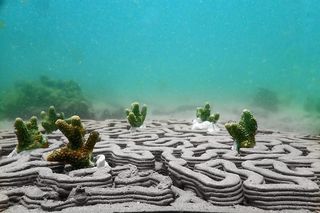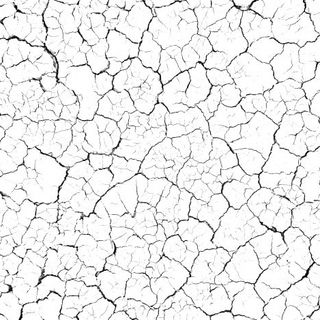
Marine Scientists In Hong Kong Are Rebuilding Coral Reefs With 3D‑Printed Tiles
A super-typhoon destroyed 80 percent of the corals in the area in 2018, and it will take decades for the species to regenerate naturally.

A research team in Hong Kong has created the first 3D-printed terracotta ‘reef tiles’ for a project aimed at rebuilding coral reefs off the coast of the city.
Hoi Ha Wan Marine Park in Hong Kong, a 2.6 square kilometre local biodiversity hotspot that is home to more than 60 species of coral, suffered mass destruction in 2018 when a super-typhoon destroyed 80 percent of the corals in the Hoi Ha Wan bay, off the Sai Kung peninsula. Now, a team of marine scientists and architects from the University of Hong Kong have executed a week-long deployment exercise in mid-July at three sites of coral disintegration within the marine park — placing 128 hexagonal ‘reef tiles’ across roughly 40 square metres. “I like to use the analogy of Jenga. The more blocks you have together, the less likely it will be to collapse,” Vriko Yu, a doctoral student from the University of Hong Kong, who is involved in the project, told Hong Kong Free Press.
Experts believe that without this intervention, it would take decades for the coral reefs to regenerate naturally — coral fragments cannot easily attach to seafloor, and their delicate tissues are also at risk from abrasive grains of sand. So, the tiles were seeded with coral fragments, which were thus lifted off the seafloor, and placed at an elevation: first, to prevent the sand from damaging them; and second, to bring them closer to sunshine, nutrients and food. The objective is “to create a hard bottom on a sandy seafloor,” David Baker, one of the leading marine scientists on the project, told The Guardian. “Sand is really not great for corals as it can move and bury or scour the coral’s thin tissues. Most corals that end up in sand usually suffer a slow death… Our hope is that the tiles provide a solid foundation for corals to reach a durable size” he added. The variety of corals that have been seeded are also intended to create a biodiverse environment within the sites.
Unlike metal or concrete alternatives, terracotta was chosen since it will naturally erode, and disappear into the seafloor with time — making it an environmentally-friendly option. “Our hope is that the our planted corals can become big enough to stabilise themselves and form a natural habitat,” Yu said. Going forward, the sites will be monitored quarterly by the team to collect data on the amount of coral that have taken to the tiles, and check the biodiversity levels within the developing reefs. And, so far, the results have been positive. “It’s encouraging that we see many species like small fish and crabs taking refuge in the tiles almost as soon as they touch the seafloor,” Baker noted.
Related on The Swaddle:
Neon Colors Help Corals Fight Bleaching, New Research Says
Hong Kong is believed to have one of the harshest environments for corals to thrive in — so much so, that corals that can grow and flourish there are touted “super-coral“. “Hong Kong is not an easy place for coral… [But] if we can do it in Hong Kong, we believe other metropolises can do it, too,” Yu noted. However, the researchers in Hong Kong also worry that red tides and typhoons can wash their efforts away “in a blink of an eye.”
In the meantime, similar projects are already ongoing in several parts of the world. The first 3D-printed reef was sunk off Bahrain in the Persian Gulf, as early as 2012. At present, the largest artificial reef in the world rests in the Maldives, where it was installed in August 2018. Made of ceramic, similar to the calcium carbonate found in actual coral reefs, experts found that the structure immediately attracted marine life, and was soon inhabited by thousands of creatures. However, there is still some time until it can be deemed successful. Another artificial reef made of a sand-based concrete, currently, rests at the Calanques National Park in France. In the Caribbean, and the Mediterranean, too, similar restoration efforts are underway. At the same time, scientists in Australia are using a cloud brightening prototype on the cloud cover above the Great Barrier Reef, to prevent coral reef bleaching caused by global warming.
But, even as the Hong Kong researchers remain hopeful, experts believe it is not a permanent solution to the global destruction of coral reefs due to climate change, and other destructive human activities. “3D printing does have a promising role in generating small complex substrates on which coral larvae can be settled and reared. But with several tens of thousands of square kilometres of reef already trashed globally over the last 50 years 3D printing is clearly not a solution, but may have some minor role. The only solution is to curb greenhouse gas emissions,” Alasdair Edwards, emeritus professor of coral reef ecology at Newcastle University, told The Guardian, commenting on Hong Kong’s project.
Devrupa Rakshit is an Associate Editor at The Swaddle. She is a lawyer by education, a poet by accident, a painter by shaukh, and autistic by birth. You can find her on Instagram @devruparakshit.
Related


Earthworms Have Made Their Way to The Arctic, Threatening An Already Delicate Ecosystem
